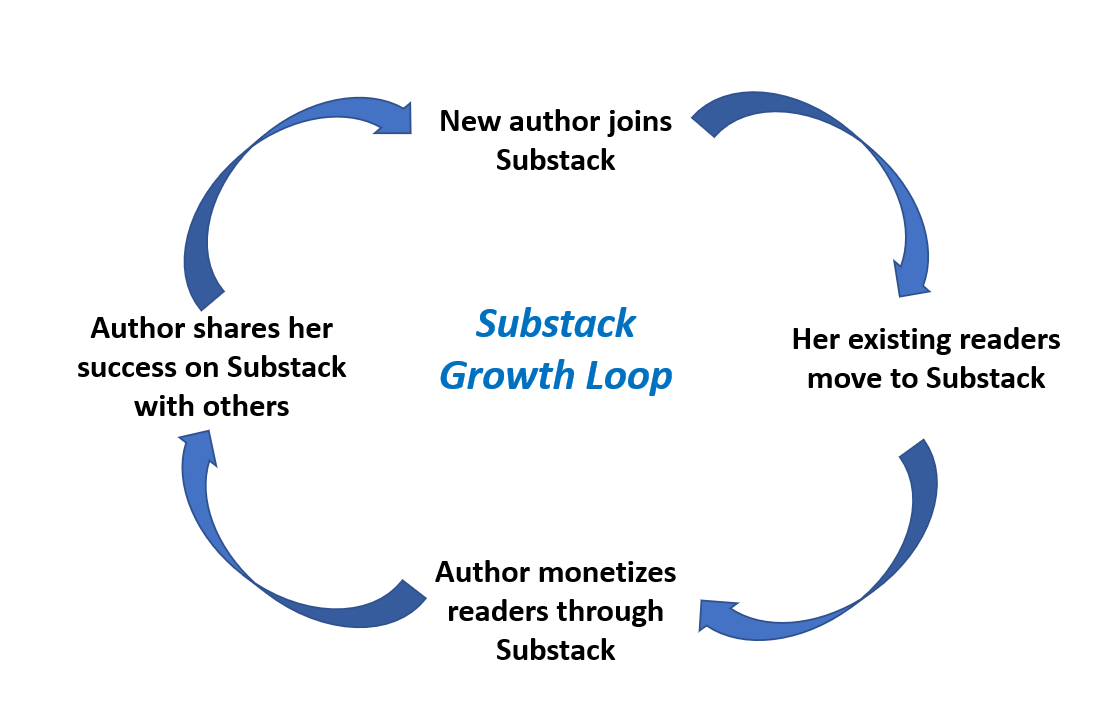
Recently a16z (a highly reputed Silicon Valley VC firm) invested in a newsletter start-up Substack. When this investment was made, people on the side-lines noticed two things: (a) Substack had only 3 employees (all co-founders) making this perhaps the largest investment per capita for a16z (b) Newsletters as a way for authors to connect with their audience have potential to become mainstream. You can read more about their investment hypothesis, penned by Andrew Chen (from a16z) here. (If you noticed, this blog also runs on Substack).
Newsletters provide an old but unique way for creators to reach their audience directly, bypassing the brutal algos of Twitter and Facebook as the articles land directly in your inbox. A platform which provides an easy set-up, seamless payment integration and ability to maintain archives/send emails, allows the creators to monetize their readers through subscription rather than ad-based model. There are authors (apparently) on Substack whose dollar annual income crosses 6 digits easily, all through subscription model.
A couple of days back, a16z posted a podcast which had Robert Cottrell (Creator at The Browser), Chris Best (CEO, Substack), Sonal Chokshi (Editor In Chief, a16z and showrunner, a16z Podcast), and Andrew Chen (Partner, a16z) , discussing all things content, newsletters, relevance of platforms and relationships with readers.


Listening to this podcast (and using Substack now for over a month), prompted a series of thoughts, which I shared in a Twitter thread (copied below). But as Twitter works, hardly anyone got to this Twitter thread and hence this article.


I share my thoughts on Substack, newsletters and the allure of personal branding below in three sections: (a) Internet’s inverted V and barriers to entry (b) The case for discovery (c) Substack’s growth loops.
Internet’s inverted V and barriers to entry
As we know, the internet has an inverted V, with creators on top, customers in the middle and users at the bottom, with each slab larger than the slab above it.

Every few years, we get a platform, which lowers the barriers of entry for the users to move to the creators slab.
YouTube started with this premise where anyone with a video camera can record and upload her own videos. Instagram provided users with filters that made their ordinary images look like professional images and elevated regular users as photo artists. LinkedIn provided users in offices a place to come together and share their views on professional matters, thus lowering the barriers of becoming a thought leader. More recently TikTok lowered the barriers in creating videos to users from tier 2 and 3 cities, democratizing the video creation ecosystem (something that YouTube had gravitated away from).
The movement from users to creators is driven by the need for currency, which is of two types (a) Social currency (aka personal branding, fame, reputation, etc.) (b) Financial currency (aka money). As the universe works, social currency has to be earned before financial currency. Platforms which are able to significantly lower the entry barriers for users to become creators and earn either social or financial currency (or both) are blessed with large valuations and MAUs.
It is interesting to note that there is no platform yet which has lowered the entry barriers for ‘written content’. Medium (www.medium.com) was an early starter here but even after many years of existence has struggled to find PMF and a sustainable monetization strategy. Thus, high quality authors have to either still work for large publications (such as WSJ, New York Times, etc.) or go through the onerous task of running+maintaining a WordPress blog, set-up payment mechanism, email templates + automation, etc. resulting in extremely high friction for authors.
This provides an interesting wedge for start-ups like Substack, to take up the vacant space of being a platform for creating written-first content. That being said, Substack, currently seems to be focused only on the top end of the inverted V - the creators.
A closer inspection reveals that everything in Substack is geared towards reducing friction for this set of people - lightning quick set-up, minimalistic article editor, ability to import existing subscribers, seamless payment integration with Scribe, automated mail delivery, only basic stats in the dashboard, etc. Authors with existing strong personal brand can easily migrate their followers (from which ever other platform they were using) to Substack and start monetizing them through subscription.
As discovery is almost non-existent on Substack (more on that in the next point), a user who is aiming to gain social currency (strong personal brand), finds it extremely hard to get any eyeballs to her content, how so ever terrific that content may be. The barriers to entry still remain very high and users have no incentive to become creators through Substack.
This looks like a very questionable strategy for a venture-backed start-up, which must be chasing scale and growth. Substack currently makes money by charging 10% from the subscription fees of paid newsletters (creators pay no money). Assume that ASP for newsletters on Substack is $10 pm and as a venture-backed start-up Substack is aiming to make $50 MM revenue in the next 3-4 years. For this Substack will need 4.2 MM paying subscribers per month, which seems to be a very very tall order from the current 50,000 paid subscribers (source). It is a tall order not because there aren’t enough readers in the world, but because there aren’t enough pre-branded authors in the world who can get these many paid subscribers.
The case for discovery
Unacademy (www.unacademy.com) is an Indian start-up in the online courses space. It is helping independent teachers (users) create courses (creators) enabling them to monetize their courses (financial currency), which is driven by the popularity of the teacher on the platform (social currency) and even beyond the platform. The difference between Substack and Unacademy is that the latter has strong content discovery embedded in the product, unlike Substack.
The platforms mentioned early in the previous section (YouTube, TikTok, LinkedIn, etc.) lower the barriers to entry by (a) tools which allow users to create content (b) ability for other users to discover the content (which is mostly an algorithmic feed). Substack does (a) but doesn’t move the needle much on (b).
I think this is driven right now primarily by the belief of the founders that in a world of very high noise to signal ratio (think Twitter feed), they are providing a noise-free medium, for authors-readers to connect through a platform (emails) which is asynchronous, personal and low friction.
And this is where for me the biggest irony of newsletter platforms lies. If you are a user, trying to become a creator using Substack (or other newsletter platforms), you publish on Substack, then take the link and put it on your social handles (Twitter, LinkedIn, Facebook, etc.) to attract readers. This essentially makes the content discovery out of Substack and onto the same very high noise to signal ratio platforms, which newsletter platforms are ridiculing for being attention monsters.
It is interesting to note here that, while these very high noise to signal ratio platforms start with the brand promise of converting users to creators, almost all of them over time gravitate towards the 90/10 rule, where 90% of views are coming from 10% of users (something like the curve below).

Now this sort of distribution is something that works for these platforms as the monetize users through ads, where the value of each impression is the same, irrespective of if it was done by President Obama or me, as long as the impression can be counted & attributed. However, for a subscription-based model, this can create significant challenge in attracting new authors, as the financial currency gets completely skewed towards a few large authors and everyone else making almost nothing. And without new/diverse authors, it is a challenge to attract new paying readers (remember it is the reader who pays to the platform).
This brings us to the third point, growth loops.
Growth Loops
I will be honest here; I have really struggled to put together growth loops for Substack. As it is a platform with 2 segments - authors and readers, both need to be accounted for in the growth loop. However, unlike say Pinterest, the platform is not geared towards converting readers to authors and hence, it is difficult to get the connect between the two.
For the sake of ease of understanding, let’s look at the author growth loop first.

This seems fairly straightforward and something that is already in motion on Substack. Here, ‘existing readers move to Substack’, doesn’t always mean that the author is importing her contacts through a CSV to Substack, but also the followers on Twitter or the newspaper where she wrote, can now follow the author on Substack.
The reader growth loop is trickier, because I don’t think it actually exists right now on Substack. This seems to be the reader growth loop right now on Substack.

As you can see, two things are happening here:
Because of lack of discovery, the readers are getting aligned to a particular author, the one which is shared by their connections on a high noise to signal feed
Also, the onus of discovery of content is on the reader and not on the platform
A better reader growth loop for Substack and newsletter platforms will be the one as shown below.

So, what does this mean?
To me it means the following three things:
Substack and newsletter start-ups need to enable a content discovery mechanism to enable the larger reader growth loops. It will not be the feed in the conventional way, but in some way similar to the feed as we know it
It is also a strategy question: Does Substack want to be a platform for writers or does it want to become a platform for discovery of great content. While the difference may sound trivial, it will have a huge impact on how Substack prioritizes its product roadmap, rolls out features, recruits people and attracts readers. These are not necessarily either-or choices and more like two ends of a spectrum, but the answer to this question can enable/disable a larger reader growth loop (remember the reader pays to Substack)
Lastly, if you are a user aiming for social currency (and like me also financial currency), Substack is not quite ready for you. It does not mean that you should give up on the platform and move somewhere else. It means that it will take much longer for you to hit your goals, than you thought, which is not always good news
Rohit
PS: If you like what you read, please do subscribe to the newsletter using the button below. It’s free, gives me direct connect with you and takes 10s.



